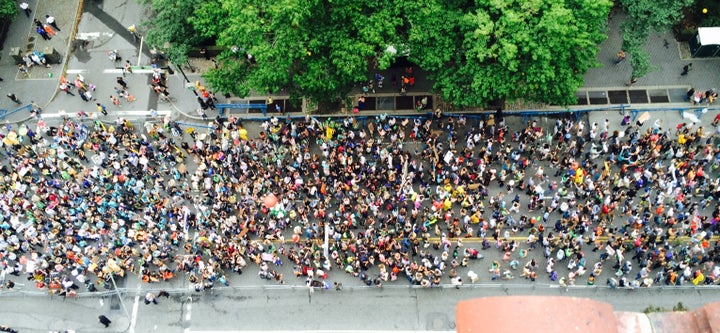
Grassroots feminist organizers across the globe have called for Wednesday, March 8, 2017 to be a one-day strike for women around the world.
The event, which coincides with International Women’s Day, has generated significant media attention ― some positive, some not ― with outlets positioning it as a test of the power of the wildly popular Women’s Marches that took place in January around the country and world.
Thinking about joining the strike, and curious about what that actually means?Here are the basics.
Plans for the strike pre-date Trump’s win.
Although the strike only began garnering mainstream media attention in the United States within the last month or so, plans for it actually began to come together last October. Inspired by the recent mass mobilizations in Argentina, (where thousands of women protested against gender violence) and Poland (where women pushed back against a proposed abortion ban ― and won) organizers from Poland reached out to activists in South Korea, Russia, Argentina, Ireland, Israel and Italy, devising plans for the proposed March 8 event, which they called the “International Women’s Strike.” (Women are now participating in 35 countries, the organizers say.)
Buoyed by the massive turnout of the recent Women’s Marches, a group of volunteer activists in the U.S. decided to join the International Women’s Strike, describing their plans in a widely circulated story for The Guardian. There are 19 members on the national planning committee.
Then in February, the organizers of the Women’s March took to social media, announcing their plans for “A Day Without A Woman” general strike, though they did not specify a date. At that point, the activists behind the International Women’s Strike and the Women’s March decided, essentially, to combine efforts.
“I think it was the January 21 mass mobilization during the Women’s March that gave many of us the confidence that the time was right to actually take up the call that the feminists internationally had given for March 8,” Tithi Bhattacharya, an activist, historian and member of the International Women’s Strike USA’s national planning committee, told The Huffington Post. (Representatives for the Women’s March did not respond to requests for comment.)
And while the two organizations’ platforms are not identical, they are closely aligned, calling for ― among other things ― reproductive justice for women, labor rights and an end to gender violence. Here’s more from the Women’s March organizers, and from the International Women’s Strike USA.
Organizers are calling for women to stop working ― however they can.
The core action of the strike is simple, organizers say: If you can, take the day off from paid and unpaid labor. Women comprise nearly half of the United States labor force, and their absence there would certainly be felt. But they also do the bulk of the unpaid work, cooking, cleaning and caring for children.
Rallies and marches are being planned across the country for the strike day, and organizers are also encouraging women to lead their own. In New York City, for example, there will be an afternoon rally in Washington Square Park. But smaller cities and towns across the country are also planning rallies, demonstrations and walkouts ― places like Weston, West Virginia and Wakefield, Rhode Island, which is hosting a march for women during dinner time on Wednesday night.
“The strike is very consciously using a diversity of actions to talk about women’s labor, because women’s labor is most often rendered invisible, both by society and by policymakers,” Bhattacharya argued. “To strike as a woman worker is not just to strike in the workplace, but to understand the unity between domestic roles and public roles that as women we constantly have to straddle.”
If you can’t strike, you can wear red to show solidarity.
The various strike organizers understand there are many, many women who are unable to strike ― women who lack protections at work, for example, as well as single mothers or healthcare professionals who cannot abandon their patients’ care. They are urging those women ― as well as all women who strike ― to wear red in solidarity with the movement.
The “Day Without A Woman” site also specifically asks women to refrain from shopping on strike day, making exceptions for small, women- and minority-owned businesses. And they’re encouraging men to lend their support to the strike by “leaning into” housework, wearing red and giving women paid days off if they’re in a position to do so.
Many of those measures will be difficult to track and quantify, Bhattacharya admitted, a fact critics may seize on after the fact to argue the strike had little tangible effect. Bhattacharya did not provide an estimate of how many women might be expected to participate, though with the Women’s March organizers throwing their considerable social media presence behind it, the event certainly has a high profile. (Though the Women’s March Facebook page does not have numbers about how many women have indicated they will strike, it has more than 700,000 followers.)
And Bhattacharya argued that the organizers are already pleased with the alliances and networks the strike has helped form, and hopes the strike will help mobilize even more women to push back against systemic inequality. The March 8 event comes after the recent ‘Day Without Immigrants’ and Yemeni Bodega strike.
“Given the fact that this is an entirely grassroots mobilization ... it will be uneven across the board,” Bhattacharya said. “It will be quite large in cities, like New York, Chicago, Los Angeles, Philadelphia. In other cities, it will vary in size, but I think this is going to be a significant mobilization nationally.”
This Women’s History Month, remember that we have the power to make history every day. Follow along with HuffPost on Facebook, Twitter and Instagram in March using #WeMakeHerstory.
